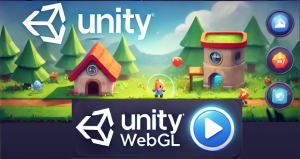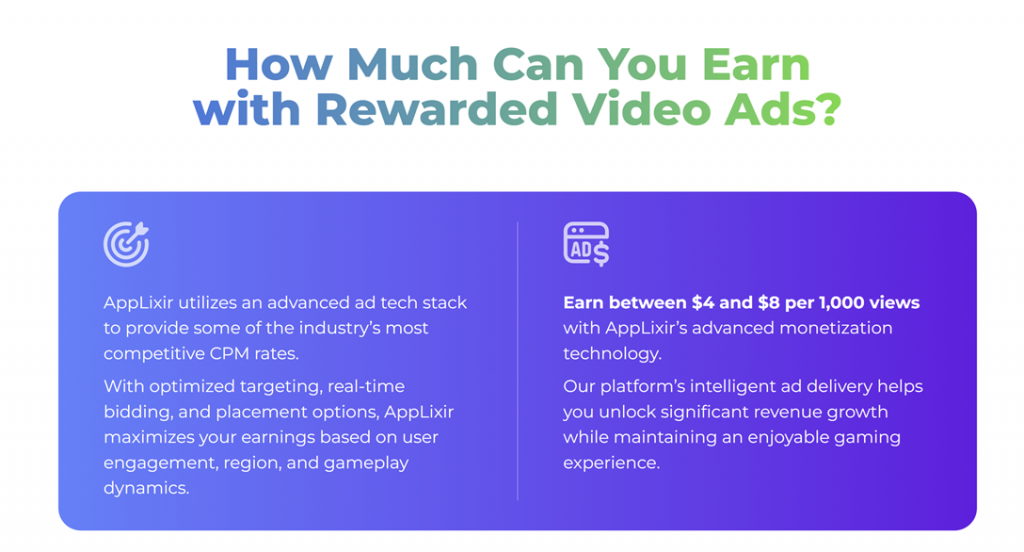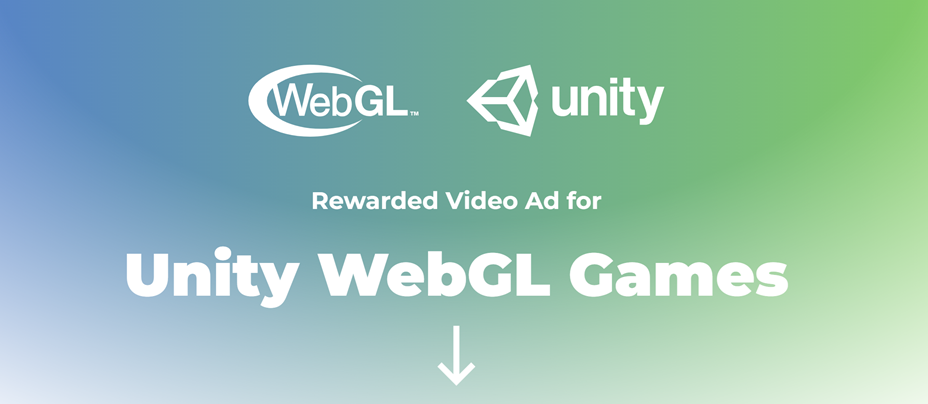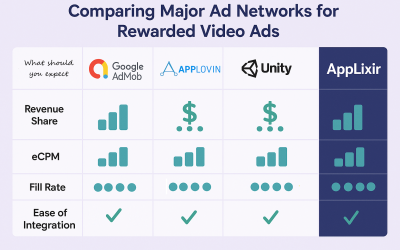The Ultimate Guide for Unity WebGL Monetization
WebGL gaming has seen a significant rise in popularity, offering developers the ability to create rich, interactive 3D experiences directly in web browsers without the need for plugins. This advancement has opened new avenues for game development and distribution, making it more accessible to a broader audience.
For developers, monetizing WebGL games is crucial. Effective monetization strategies not only provide a return on investment but also fund future development and updates. The goal of this guide is to help developers maximize ad revenue while ensuring a great user experience.
[ez-toc]
Contents
- 1 What is WebGL Monetization?
- 2 WebGL Game Monetization Models
- 3 Rewarded Video Ads for Unity WebGL Games: Our Focus
- 4 How Rewarded Ads Work in WebGL Games:
- 5 Best Practices for WebGL Monetization
- 6 Common Challenges & How to Overcome Them
- 7 Monetization Metrics & Performance Tracking
- 8 AppLixir Rewarded Video Ad for WebGL Games
What is WebGL Monetization?
WebGL monetization refers to the various methods developers use to generate revenue from games built using WebGL technology. Unlike mobile or console games, WebGL games run directly in web browsers, which presents unique opportunities and challenges for monetization.
Monetizing WebGL games differs from other platforms due to factors like user expectations, browser capabilities, and the ease of access to games. Players often expect free-to-play models with optional purchases or ads, and developers must optimize for various browsers and devices.
Key Monetization Strategies for WebGL Developers
- Ad-Based Monetization: Displaying ads within the game environment.
- In-Game Purchases (Microtransactions): Offering players the option to buy virtual goods or enhancements.
- Subscriptions & Memberships: Providing premium content or features for a recurring fee.
- Offerwalls & Incentivized Ads: Allowing players to engage with ads or offers in exchange for in-game rewards.
- Sponsorships & Branded Content: Collaborating with brands to feature their products or services within the game.
WebGL Game Monetization Models
Ad-Based Monetization
Continuing on “The Ultimate Guide for Unity WebGL Monetization” post, Ad-based monetization is one of the most common ways to generate revenue from WebGL games. It involves integrating advertisements such as banner ads, interstitial ads, and rewarded video ads directly into the game. This model provides a steady revenue stream without requiring players to spend money. However, if not implemented thoughtfully, ads can disrupt the gaming experience. Overuse of ads may also lead to player frustration, causing them to abandon the game.
In-Game Purchases (Microtransactions)
In-game purchases, or microtransactions, offer players the ability to buy virtual items like skins, power-ups, or in-game currency to enhance their gameplay experience. This monetization model provides significant revenue potential while allowing players to customize their gaming experience. However, developers must carefully balance in-game purchases to avoid a “pay-to-win” perception, which can deter players. Additionally, to sustain interest, developers need to continuously update the game with new content and purchasable items.
Subscriptions & Memberships
Subscriptions and memberships provide a more predictable revenue stream by charging players a recurring fee for access to exclusive content, premium features, or other in-game benefits. This model encourages long-term player engagement, as subscribers feel invested in the game. However, convincing players to commit to ongoing payments can be challenging, especially if there isn’t enough value offered in the subscription. Regular content updates are necessary to keep subscribers engaged and justify the recurring cost.
Offer walls & Incentivized Ads
Offerwalls and incentivized ads present another monetization option, allowing players to engage with advertisements or complete offers in exchange for in-game rewards. This method generates revenue without requiring direct spending from players and can enhance engagement when rewards are desirable. However, if not integrated seamlessly, offerwalls and incentivized ads can disrupt gameplay and negatively impact the user experience. Furthermore, there is a risk of attracting low-quality user engagement, as some players may interact with ads solely to claim rewards without genuine interest.
Rewarded Video Ads for Unity WebGL Games: Our Focus
Rewarded video ads are a powerful monetization tool that allows players to choose whether they want to watch an advertisement in exchange for in-game rewards. These rewards can include extra lives, virtual currency, special power-ups, or exclusive in-game items. Unlike other forms of advertising, rewarded video ads provide an interactive and value-driven experience for players, making them one of the most effective ad formats in WebGL gaming.
Why Rewarded Video Ads Are Effective
One of the key reasons rewarded video ads perform well is their voluntary engagement. Since players opt-in to view these ads, they are more receptive to the content, resulting in higher engagement and completion rates. Unlike forced ad placements, this approach ensures that players feel in control, making them less likely to be frustrated by interruptions.
Continuing on “The Ultimate Guide for Unity WebGL Monetization” post, Another advantage is the enhanced user experience. Many players prefer watching a short ad over making an in-game purchase, especially in free-to-play WebGL games. By offering valuable in-game rewards in exchange for ad views, developers create a win-win situation where players benefit while revenue is generated. Since rewarded video ads do not require direct monetary spending from users, they provide an effective monetization strategy without negatively impacting the accessibility of the game.
Finally, rewarded video ads lead to increased revenue compared to other ad formats. Because players actively engage with these ads and are more likely to complete them, the earnings per impression tend to be higher. Advertisers are willing to pay a premium for high-engagement placements, which often results in better revenue for developers compared to standard banner or interstitial ads.
How Much Do Rewarded Video Ads Pay?
The revenue generated from rewarded video ads depends on several factors, including the game’s genre, audience demographics, player engagement, and the ad network used. A crucial metric for determining ad earnings is Cost Per Mille (CPM), which refers to the amount an advertiser pays per 1,000 ad impressions. For rewarded video ads, CPMs can range from $5 to $10, but this figure varies based on factors such as region, user behavior, and the overall demand from advertisers. Games with a highly engaged audience and longer session durations tend to see better monetization performance from rewarded video ads. Check our Revenue Calculator for more information!
The Benefits of Rewarded Video Ads
Continuing on “The Ultimate Guide for Unity WebGL Monetization” post, One of the biggest benefits of rewarded video ads is improved player retention. By allowing users to earn valuable in-game rewards through ad engagement, developers can encourage players to stay in the game longer. Instead of hitting a paywall or being forced to wait for an energy refill, players can continue playing simply by watching a short video ad.
Another major advantage is the positive player sentiment that comes with optional monetization. Since players can choose whether or not to engage with ads, they tend to view rewarded video ads as a helpful feature rather than an annoyance. This is a crucial difference from other ad formats, such as interstitial ads, which can be perceived as disruptive. By respecting the player’s choice, developers foster goodwill and maintain a more enjoyable gaming experience.
Lastly, rewarded video ads offer non-intrusive monetization. Unlike traditional ad placements that interrupt gameplay, rewarded ads only appear when players actively opt-in. This ensures that the flow of the game remains smooth and uninterrupted, keeping players immersed in the experience while still generating ad revenue.
The Challenges of Rewarded Video Ads
Despite their many benefits, rewarded video ads come with certain challenges. One of the most significant risks is overuse. If developers rely too heavily on rewarded video ads, players may feel pressured to watch multiple ads in a short period, leading to fatigue and potential disengagement. Striking the right balance between monetization and user experience is key to maintaining long-term player retention.
Another challenge is content relevance. Since rewarded video ads are delivered by third-party advertisers, there is always a risk that some ads may not align with the interests of the player base. Poorly targeted ads can frustrate players and diminish the effectiveness of the ad experience. Developers should work with reputable ad networks that offer better targeting and filtering options to ensure higher-quality ads.
Finally, technical integration can be a hurdle for developers who are unfamiliar with ad SDKs. Implementing rewarded video ads in a WebGL game requires seamless integration with an ad network’s software development kit (SDK), proper handling of reward distribution, and compliance with ad network policies. Ensuring smooth performance across different browsers and devices adds an extra layer of complexity, making it essential for developers to thoroughly test their implementation before launching.
By carefully addressing these challenges and optimizing the implementation of rewarded video ads, WebGL game developers can maximize their revenue while maintaining a positive and engaging experience for players.
How Rewarded Ads Work in WebGL Games:
Continuing on “The Ultimate Guide for Unity WebGL Monetization” post, In WebGL games, rewarded video ads are typically integrated using JavaScript SDKs provided by ad networks. Integrating rewarded video ads into Unity WebGL games can be achieved through platforms like AppLixir, which offers a straightforward process:
- Sign Up on AppLixir: Create an account on AppLixir’s website and register your game.
- Add unity SDK to your project, download and add the SDK package to the projects using the menu “Assets -> Import package -> Custom Package”, then navigate to the downloaded .unitypackage file. This will create an Applixir folder inside your project.
- Initialize and Use the SDK: Before displaying rewarded videos, initialize the SDK using ApplixirWebGL.Initialise(). To show a rewarded video ad, call ApplixirWebGL.PlayVideo(..) with a callback to handle the video’s result and determine the player’s reward.
For a detailed guide, refer to AppLixir’s documentation. Additionally, Unity’s official documentation provides guidance on implementing rewarded ads, including setting up buttons that prompt players to opt-in to watching ads in exchange for rewards.
By following these steps, developers can effectively integrate rewarded video ads into their Unity WebGL games, enhancing monetization while maintaining a positive player experience.
Best Practices for WebGL Monetization
Continuing on “The Ultimate Guide for Unity WebGL Monetization” post, To successfully monetize Unity WebGL games, it’s essential to balance revenue generation with user experience. Here are some best practices:
- Ad Placement: Integrate ads at natural breakpoints, such as between levels or after a game session, to minimize disruption. Avoid placing ads mid-game or too frequently, as this can frustrate users and lead to player drop-off.
- Frequency Capping: Limit the number of ads shown to a user within a specific timeframe to prevent ad fatigue.
- Reward Relevance: Ensure that the rewards offered for watching ads are valuable and relevant to the player, enhancing their gaming experience.
- User Control: Allow players to choose whether to watch an ad for a reward, maintaining a sense of control and preventing negative perceptions.
- Testing and Optimization: Regularly test different ad placements, formats, and frequencies to determine what works best for your audience. Use analytics to track performance and make data-driven decisions.
By adhering to these best practices, developers can create a monetization strategy that maximizes revenue without compromising the player experience.
Common Challenges & How to Overcome Them
Monetizing WebGL games comes with its set of challenges. Here’s how to address some common issues:
- Ad Blockers: Many players use ad-blocking software, which can reduce ad impressions and revenue. To mitigate this:
- Detect Ad Blockers: Implement scripts to detect if an ad blocker is active.
- Communicate with Players: Politely inform users about how ads support the game’s development and encourage them to white-list your site.
- Offer Ad-Free Options: Provide an option for players to purchase an ad-free version of the game.
- Low Ad Fill Rates: This occurs when there aren’t enough ads available to serve to your players, leading to missed revenue opportunities. To improve fill rates:
- Partner with Multiple Ad Networks: Collaborate with several ad providers to ensure a steady supply of ads.
- Optimize Ad Placements: Ensure that your ad placements meet the requirements of various ad networks.
- Monitor Performance: Regularly review analytics to identify and address issues promptly.
- Balancing Monetization and User Experience: Overloading your game with ads can lead to a poor user experience, causing players to leave. To maintain balance:
- Implement User-Friendly Ad Formats: Use non-intrusive ad formats like rewarded videos that offer value to the player.
- Limit Ad Frequency: Ensure that ads are shown at appropriate intervals and do not disrupt gameplay.
- Gather Player Feedback: Regularly solicit feedback to understand how players feel about the ads and adjust accordingly.
By proactively addressing these challenges, developers can create a sustainable monetization strategy that supports both revenue goals and player satisfaction.
Monetization Metrics & Performance Tracking
Continuing on “The Ultimate Guide for Unity WebGL Monetization” post, To optimize monetization efforts, it’s crucial to track key performance metrics:
- CPM (Cost Per Mille): The amount advertisers pay per 1,000 ad impressions. A higher CPM indicates more valuable ad placements.
- eCPM (Effective Cost Per Mille): Calculated by dividing total earnings by the number of impressions (in thousands). It provides insight into overall ad performance across different formats.
- ARPDAU (Average Revenue Per Daily Active User): Measures the average revenue generated per active user per day. It’s a vital metric for understanding the game’s revenue efficiency.
- LTV (Lifetime Value): Estimates the total revenue a player will generate over their entire time interacting with the game. This helps in making informed decisions about user acquisition and retention strategies.
Utilizing an ad revenue calculator can assist in forecasting earnings and setting realistic revenue goals. By inputting metrics like DAU, ad impressions, and CPM, developers can estimate potential earnings and adjust their strategies accordingly.
Regularly monitoring these metrics allows developers to make data-driven decisions, optimize ad placements, and enhance overall monetization strategies.
AppLixir Rewarded Video Ad for WebGL Games
Monetizing your Unity WebGL game shouldn’t be a hassle. AppLixir offers a seamless, high-eCPM rewarded video ad solution designed specifically for WebGL. With lightweight SDK integration, cross-browser compatibility, and a non-intrusive ad experience, AppLixir helps you maximize ad revenue without disrupting gameplay. Trusted by top developers, we provide higher engagement rates and better player retention—so you can focus on building great games while we handle monetization. Ready to boost your WebGL game’s earnings? Let AppLixir handle it!”




